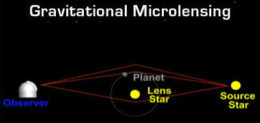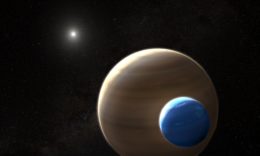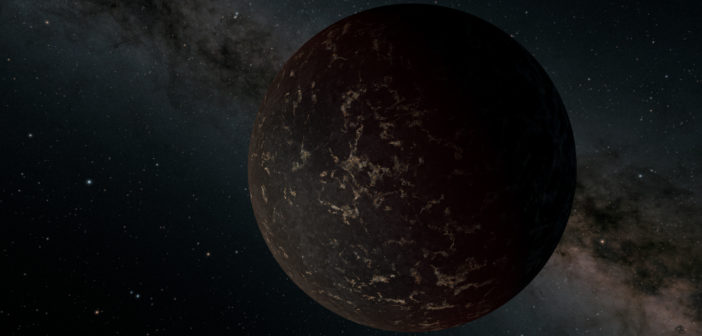Editor’s note: This week we’re in Reykjavik, Iceland at the Extreme Solar Systems (ExSS) IV meeting. Follow along to catch some of the latest news from the field of exoplanet research!
Day 1 of ExSS started off at a breakneck pace! This is my first time attending this conference, and I wasn’t expecting the rapid pace of talks (10–15 minutes each, all in back-to-back rather than parallel sessions) and the density of information in them. I expect to be fairly overwhelmed by the end of the week, but so far this has been an awesome way to get a broad sense of the many different recent exoplanet discoveries and what we’re learning about our universe as a result.
Session 1: New Discoveries
What missions are involved in the hunt for exoplanets? What have they found so far, and what can we expect in the future? The first session provided a rapid overview of a few active exoplanet missions and recent discoveries we’ve made.

TESS will finish tiling the sky in its prime mission in 2020, at which point it will move on to the extended mission. Click to enlarge. [AAS Nova/George Ricker]
Eric Nielsen (Stanford) next updated us on results from the Gemini Planet Imager Exoplanet Survey (GPIES), which is a ground-based direct-imaging mission hunting for giant planets and brown dwarfs that orbit at distances of 10 to 100 AU from their host stars. So far GPIES has discovered six giant planets and four brown dwarfs — not yet many, but even with these small-number statistics, the GPIES team has been able to start drawing conclusions about the differences between brown-dwarf and giant-planet populations.
What are some particularly interesting recent planet discoveries?
- David Charbonneau (Harvard) thinks we’ve found the perfect target for studying the atmosphere of a rocky, Earth-like planet: LT1445Ab, an apparent terrestrial planet in a triple-star system. At less than 23 light-years away, this is the closest transiting planet we’ve discovered around an M dwarf, making it an excellent target for spectroscopic follow-up.
- Anne-Marie Lagrange (Grenoble) described a new discovery in the Beta Pic system. The closest giant planet we’ve directly imaged is in Beta Pic — but now scientists have discovered it has a sibling. This second giant planet was detected spectroscopically, making Beta Pic the first system to host both a planet detected in imaging and one detected with indirect techniques.
- It’s been suspected — but not confirmed — that terrestrial planets orbiting M dwarfs should have a difficult time retaining their atmospheres due to photoevaporation by their host stars. Laura Kreidberg (Harvard) and collaborators have now measured a thermal phase curve for TESS Earth-like planet LHS 3844b, indirectly confirming that this planet doesn’t have a thick atmosphere.

A diagram of how planets are detected via gravitational microlensing. The detectable planet is in orbit around the foreground lens star. [NASA]
Session 2: Direct Imaging

One of the best-known directly imaged planets is Fomalhaut b, visible in the inset in this Eye-of-Sauron-like Hubble photo of the debris disk surrounding the star Fomalhaut. [NASA, ESA, P. Kalas (University of California, Berkeley)]
Brendan Bowler (UT Austin) discussed one of the results obtained from direct-imaging studies in aggregate: observations suggest that brown-dwarf companions tend to have higher eccentricities, whereas long-period planets preferentially have low eccentricities. This suggests that giant planets are a distinct population from low-mass stars, and they likely formed within a disk.
Updates from a few specific surveys:
- The SPHERE INfrared Exoplanet (SHINE) survey is studying the population of wide-orbit companions surrounding nearby stars. Michael Meyer (U Michigan) presented a number of the survey’s recent conclusions, one of which is that the frequency of brown-dwarf companions is higher for lower-mass host stars, yet the giant-planet frequency is higher for higher-mass stars.
- The MagAO Giant Accreting Protoplanet Survey (GAPlanetS) searches for accreting planets lying in the gaps of the brightest transitional disks — disks that lie around young, still-accreting stars. This strategy of searching right where we expect to find planets has led to an impressive detection rate of 20% for the survey so far, according to Kate Follette (Amherst).
- TESS is known as a transit survey, but it turns out it may prove beneficial as a direct-imaging survey as well — just not for exoplanets. Matt Holman (Harvard-Smithsonian CfA) presented on how TESS and Pan-STARRS, a ground-based sky survey, could be used to search for distant, unseen planets in our own solar system, like the theorized Planet Nine.
Some especially interesting individual detections related to direct imaging:

Artist’s impression of a system consisting of a star, planet, and giant exomoon. [NASA/ESA/L. Hustak (STScI)]
- Cecilia Lazzoni (INAF – Padova) presented an exciting discovery of the SHINE survey: evidence for two giant exomoon candidates orbiting two low-mass brown-dwarf companions. If confirmed, this discovery could constrain planet formation mechanisms.
- Valentin Christiaens (Monash) discussed spectroscopic evidence for a circumplanetary disk around the first directly imaged protoplanet, PDS 70b. This is the first observational evidence that circumplanetary disks — long theorized — actually exist.
- HD 20782b is a hot Jupiter with the highest eccentricity known to date (e ~ 0.96). Sasha Hinkley (Exeter) described how deep VLT-SPHERE observations have ruled out additional bodies in this system that could account for HD 20782b’s extreme orbit, suggesting this planet’s unusual eccentricity may be due to unique internal structure that has prevented its orbit from circularizing through tidal dissipation.
Session 3: Radial Velocities
Another means of detecting exoplanets is radial velocities, in which we examine the spectra of stars, looking for the subtle signature of the gravitational tug of an exoplanet on its host star. The first session of the afternoon focused on some of the results that have recently emerged from radial-velocity studies.
One of the primary benefits of radial-velocity studies is the ability to measure planetary masses — but due to stellar activity muddying the waters, this process is challenging! Xavier Dumusque (Geneva) presented on one approach improving our ability to interpret radial-velocity measurements: HARPS and HARPS-N are observing the Sun as a star! Since we can make independent measurements of solar activity and our planets are well characterized, these observations help us to understand how stellar activity can affect radial-velocity measurements.
René Doyon (Montreal) introduced the SPIRou Legacy Survey, which makes use of the SPIRou spectropolarimeter to achieve precision radial-velocity measurements in the infrared. SPIRou is designed to detect small planets around nearby low-mass stars and explore the impact of magnetic fields on star/planet formation. Though the program was only launched in February, the first science results are already in, with much more to come!
Some specific recent radial-velocity detections:

Artist’s impression of two planets orbiting Teegarden’s Star. [Institute for Astrophysics, University of Göttingen]
- CARMENES, a spectrograph searching for the signals of low-mass planets around low-mass stars, has already doubled the number of known planets with host stars below 0.2 solar mass. Stefan Dreizler (U Goettingen) told us about two of the most Earth-like planets discovered, which orbit a nearby M dwarf known as Teegarden’s star. Fun fact about Teegarden’s star: our relative systems are aligned such that hypothetical Teegardians would be able to detect the Earth as a transiting exoplanet!
- Remember the discovery of Proxima b, a low-mass exoplanet found around Proxima Centauri, our nearest stellar neighbor? It turns out this planet may have a sibling. Mario Damasso (INAF – Torino) presented analysis of ~17 years of radial-velocity data of Proxima Centauri, which hints at a second planet orbiting at 1.5 AU. If confirmed, this discovery would make Proxima the closest multi-planet system to the Sun, at just 4.2 light-years.
- Caroline Piaulet (Montreal) told us about follow-up of WASP-107b, a near-Neptune-mass planet that’s the size of Jupiter and challenging planet-formation theories. Radial-velocity observations have revealed a second planet in the system on a wide and eccentric orbit, which may explain some of the strange properties of WASP-107b.
- “We’ve been monitoring this star for longer than I’ve been alive,” says grad student Sarah Blunt (Caltech) about HR 5183. More than two decades of data allowed Blunt and collaborators to detect an eccentric (e = 0.84) Jovian planet, HR 5183 b, with an orbital period longer than 70 years — the longest-period exoplanet with a well-constrained orbit discovered with radial velocities.
Session 4: Transits
The final session of the day focused on what’s perhaps the most well-known planet detection method: transits, in which we discover planets through the dip in a host star’s light as an orbiting planet passes between us and its star.
Several of the talks highlighted results from TESS:
- While TESS is directly monitoring 200,000 targeted stars in 26 sectors, it also produces full-frame, 30-minute-cadence images of its sectors. Simulated data predict that we’ll be able to find 3,000 planets in this data — but also 800,000 false positives! Adina Feinstein (U Chicago) discussed the various techniques we can use to eliminate these false positives and recover the real planets.
- Peter Plavchan (George Mason U) presented on new results still under review at Nature (which means only vague reporting is encouraged) – the TESS and radial-velocity discovery of a two-planet system around a pre-main-sequence M dwarf still surrounded by a debris disk. This system gives us a tantalizing opportunity to study how newly formed planets interact with the disks in which they live.
- Diana Dragomir (U New Mexico) introduced the HD 21749 system, jointly discovered with TESS and ground-based observations. HD 21749 serves as proof of TESS’s detection capabilities, consisting of an unusually dense, temperate sub-Neptune on a long-period orbit, as well as TESS’s first Earth-sized planet discovery.
- We’ll be hearing more about ultra-short period planets tomorrow, but James Jenkins (U Chile) gave us a teaser by presenting TESS discovery of LTT9779b, the first Neptune-like ultra short period planet, which orbits its host in just 19 hours. The planet’s equilibrium temperature is a scalding 2,000 K, giving it the distinction of forming a new category: ultra hot Neptunes.
- What about non-detections? Ji Wang (Ohio State) reported on a search for some of the earliest exoplanets formed. Wang and collaborators looked through TESS data for planets around the most metal-poor stars in our galaxy: a sample of old, Gaia-detected stars in the Milky Way halo. The search didn’t yield any discoveries, but it did place interesting constraints on planet formation in metal-poor environments.
Andrew Vanderburg (UT Austin) discussed the challenges of measuring accurate planet occurrence rates in transit surveys like Kepler, K2, and TESS. Since human judgment isn’t perfect, Vanderburg argues that automatic detection and vetting of planet candidates is the way forward. He and collaborators are working on using deep learning, a machine learning technique, to do this automated detection, and they’ve already demonstrated success in applying this to Kepler data.
Transit observations are good for more than just finding exoplanets; we can also learn about the planets’ properties. Antonija Oklopcic (Harvard) presented a new way to detect magnetic fields in exoplanets, which relies on examining a helium absorption line in a planet’s atmosphere as the planet transits. This line will become polarized in the presence of an external field, and measuring this polarization can provide constraints on the strength of the exoplanet’s magnetic field.



1 Comment
Pingback: Extreme Solar Systems IV | astrobites